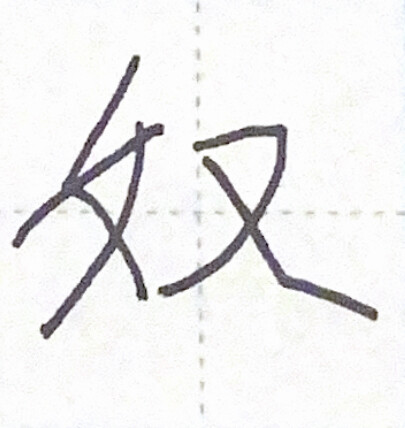珍しさそうです。
Even the sentence itself refers to this rareness, この時代に滅多に見えない!
ところが, of all the kanjis that make up the name of the novel, I find 女 most difficult to get right. @matt_in_mito さん, would you consider to add it up to your list?

珍しさそうです。
Even the sentence itself refers to this rareness, この時代に滅多に見えない!
ところが, of all the kanjis that make up the name of the novel, I find 女 most difficult to get right. @matt_in_mito さん, would you consider to add it up to your list?
Thanks for saying this. I started it thinking that I might get a couple of interested people and it would just naturally disappear after a month or so, but in contrast, it’s actually growing and becoming more and more popular, so I’m really happy and I’ll keep doing it for the time being. Feel free to post some of your own stuff, too!
This is a testament to the fact that I don’t read novels, like, ever…
I gave it a go, but I often struggle getting it right, too. See what you think! (Post incoming within the next few minutes…)
It’s actually been on my radar for a while, because I find the 草書 style very interesting.
2023年10月7日(土)
女
訓:おんな、め
音:じょ、にょ、にょう
英:woman, female
書き順
楷書
行書
草書
メモ
So, you’ll have probably noticed by my 草書 that the hiragana め was created using this character. This is connected to 雌(めす), which means ‘female’, mostly in connection with non-human animals, but was probably associated with humans at some point in history. History is my worst subject, so if anyone can shed more light on this than me, please feel free!
Nice! I like the 行書 version best, it looks to me like a lady in court curtseying. I have trouble with the balancing of the whole kanji itself but the second stroke is 最悪.
As for the 草書 version, 本当にすごくビックリしました: “why did he write ‘め’?”, I thought. Then your explanation cleared it all. (草書 is really baffling, I share your feeling about the understanding of the strokes.)
Now, the next thing that popped up in my head was “what about 男 and 雄 (おす), are they connected in the same manner”?
漢字の書道を教えてくれていつもありがとう!
It’s one that I hate to write, but get a hell of a lot of satisfaction from getting right. I’m not saying the one I posted today is anywhere near perfect, but I had a go at least…
Yes and no. A barely-used reading for 男 is ‘お’, so there is that connection, but the hiragana お has no connection to 男 as far as I’m aware.
2023年10月8日(日)
戸
訓:と
音:こ
英:door, counter for houses, door radical
書き順
楷書
行書
草書
メモ
The ‘to’ from Mito!
Apparently お comes from 於 which was used to write the お sound in 万葉仮名(Chinese characters used phonetically).

From 雌 - Wiktionary, the free dictionary " The kanji as used originally in Chinese and in older Japanese with the on’yomi of shi referred more specifically to female birds."
The characters were even apparently based on birds "雄は雌の前で翼を大きく張り広げる。 これを観察した古人は「おす」のこのような形態的特徴を捉えて「雄」という記号を作り出した(詳しくは「雄」の項で述べる)。 これに対するのが「めす」で、雄の前で翼を折り畳んでいる形状を捉えて「雌」という記号を作った"67「雌」の字源・語源 : 漢字の字源・語源図鑑
@EbonyMidget beat me to the punch but I’ll leave my post for posterity.
I was literally talking to my Japanese friend about this on Friday. The 女 is the 万葉仮名 of め. In of the word 娘 it ends with that め. The other two kanji related to that are 安→あ
奴→ぬ
Those would both be interesting to see.
@EbonyMidget @Sidgr
I love how this has become a discussion about these details. I’ll do 安 today, and I’ll put 娘, 奴 and 於 on the list for the next few days. I might do 雌 and 雄 too, since we’re on the subject.
2023年10月9日(月)
安
訓:やす.い、やす.まる、やす、やす.らか
音:あん
英:relax, cheap, low, quiet, rested, contented, peaceful
書き順
楷書

行書
草書
メモ
As stated on a previous post, the hiragana あ was made using this character.
I can’t unsee this. Perfect description 

2023年10月10日(火)
娘
訓:むすめ、こ
音:じょう
英:daughter, girl
書き順
楷書
行書
草書
メモ
I think that on this one, you can see the relationship between the hiragana め and the radical 女 a lot more.
Oh my god. I was reading @matt_in_mito’s comment and thinking to myself it was funny because I had also just learned about 曰く a couple months ago while also reading a light novel.
I then gasped reading your comment because I also learned it from 魔女の旅々 ! 
I finished volume 4 a while ago and had a great time reading it (and lost my mind seeing 曰く for the first time). Great to see someone else here reading it! Which volume are you on?
2023年10月11日(水)
奴
訓:やつ、やっこ
音:ど
英:guy, slave, manservant, fellow
書き順
楷書

行書
草書
メモ
Again, I think it’s pretty easy to understand how we got ぬ from this one. However, it is one of the few that doesn’t share a reading with its hiragana counterpart.
古代
It does seem to be a possible reading for 奴.
Wow what a coincidence! Funnily enough I’m actually about 200 pages into volume 4 at the moment. I’d probably be much farther in by now but I’m weird and like to have the physical copies when I’m reading (but unfortunately costs a lot more time and money to import)
looks like it is historical 呉音 which are usually associated with buddhist/old confucian terms and words. So not common in modern Japanese.
Is a good example, It is the Japanese borrowing of a confucian term for servant/slave.
わう!
You’ve already gone wayyy past what I know about historical calligraphy! 
2023年10月12日(木)
於
訓:おい.て、お.ける、ああ、より
音:お、よ
英:at, in, on, as for
書き順
楷書
行書
草書
メモ
I realise it might be difficult to see at first glance how this relates to the hiragana お, so I did one with a red pen, too.